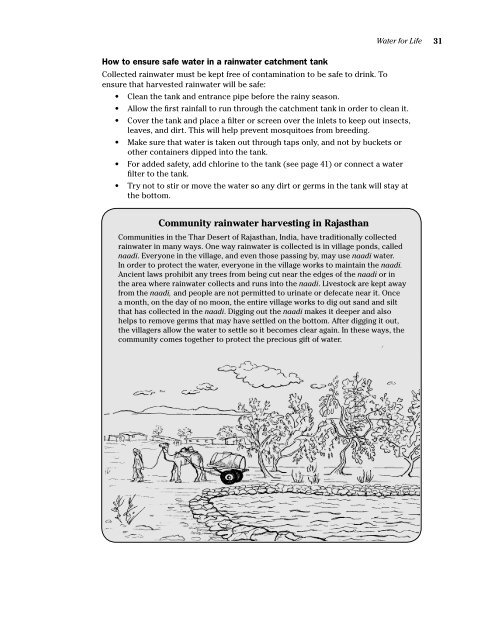Community water security - UN-Water
Community water security - UN-Water
Community water security - UN-Water
You also want an ePaper? Increase the reach of your titles
YUMPU automatically turns print PDFs into web optimized ePapers that Google loves.
<strong>Water</strong> for Life<br />
31<br />
How to ensure safe <strong>water</strong> in a rain<strong>water</strong> catchment tank<br />
Collected rain<strong>water</strong> must be kept free of contamination to be safe to drink. To<br />
ensure that harvested rain<strong>water</strong> will be safe:<br />
• Clean the tank and entrance pipe before the rainy season.<br />
• Allow the first rainfall to run through the catchment tank in order to clean it.<br />
• Cover the tank and place a filter or screen over the inlets to keep out insects,<br />
leaves, and dirt. This will help prevent mosquitoes from breeding.<br />
• Make sure that <strong>water</strong> is taken out through taps only, and not by buckets or<br />
other containers dipped into the tank.<br />
• For added safety, add chlorine to the tank (see page 41) or connect a <strong>water</strong><br />
filter to the tank.<br />
• Try not to stir or move the <strong>water</strong> so any dirt or germs in the tank will stay at<br />
the bottom.<br />
<strong>Community</strong> rain<strong>water</strong> harvesting in Rajasthan<br />
Communities in the Thar Desert of Rajasthan, India, have traditionally collected<br />
rain<strong>water</strong> in many ways. One way rain<strong>water</strong> is collected is in village ponds, called<br />
naadi. Everyone in the village, and even those passing by, may use naadi <strong>water</strong>.<br />
In order to protect the <strong>water</strong>, everyone in the village works to maintain the naadi.<br />
Ancient laws prohibit any trees from being cut near the edges of the naadi or in<br />
the area where rain<strong>water</strong> collects and runs into the naadi. Livestock are kept away<br />
from the naadi, and people are not permitted to urinate or defecate near it. Once<br />
a month, on the day of no moon, the entire village works to dig out sand and silt<br />
that has collected in the naadi. Digging out the naadi makes it deeper and also<br />
helps to remove germs that may have settled on the bottom. After digging it out,<br />
the villagers allow the <strong>water</strong> to settle so it becomes clear again. In these ways, the<br />
community comes together to protect the precious gift of <strong>water</strong>.
















